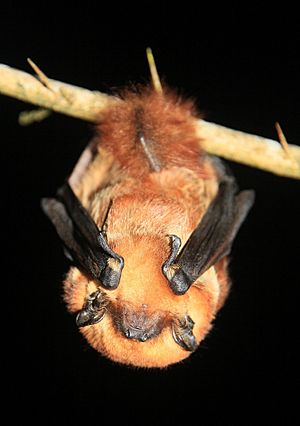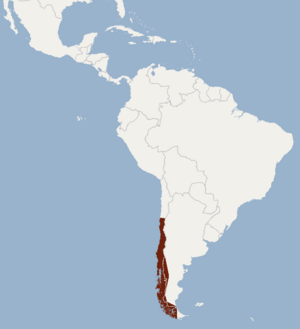Cinnamon red bat facts for kids
Quick facts for kids Cinnamon red bat |
|
|---|---|
 |
|
| Conservation status | |
| Scientific classification | |
| Genus: |
Lasiurus
|
| Species: |
varius
|
 |
|
| Distribution of the Cinnamon red bat (1992) | |
| Synonyms | |
The cinnamon red bat (Lasiurus varius) is a cool type of bat that lives in South America. It's part of the Vespertilionidae family, which includes many common bats. This bat is special because of its deep red fur. Unlike some other bats in its group, it doesn't have white "frosting" on its fur tips.
For a long time, people thought the cinnamon red bat was the same as the eastern red bat. But scientists later found out they are different. The cinnamon red bat has unique fur color and lives in a specific area. It's a small bat, usually weighing about 9.5–11.0 g (0.34–0.39 oz), which is like a few paper clips! Its forearm is about 39–42 mm (1.5–1.7 in) long.
Like many bats, it eats insects. It uses echolocation to find its prey, like moths and beetles, in the dark. This bat is found only in parts of Chile and Argentina. It has one of the southernmost homes of any bat species in the world!
Contents
What Makes It Unique?
The cinnamon red bat has long, narrow wings with black membranes. Its fur is a deep, vibrant red, which helps it stand out. Its tail membrane (called the uropatagium) is very furry, with hairs going past the edge.
The hairs on its back are actually three colors! They have black bases, yellowish middles, and bright cinnamon-red tips. It also has yellowish patches on its shoulders and a black snout. Its forehead and neck are a pale, yellowish-orange color. Even the hairs on its belly are tricolored, but the black part is much longer.
Bat Family Tree
The cinnamon red bat was first described in 1835 by a German scientist named Eduard Friedrich Poeppig. He gave it the scientific name Nycticeius varius. The first time it was called Lasiurus varius was in 1870.
For over a hundred years, many scientists thought this bat was just a type of eastern red bat. This meant they thought the eastern red bat lived all the way from Canada to the very tip of South America! However, starting in the 1980s, scientists began to see that the cinnamon red bat was indeed its own species. They noticed its unique fur color and that it only lived in a certain area.
Later, in 2015, genetic tests confirmed that the cinnamon red bat is very different from the eastern red bat. It's like finding out two cousins who look alike are actually from different branches of the family tree!
Life and Habits
Like all bats in its group (the Lasiurus genus), female cinnamon red bats have four teats. This is quite unusual, as most female bats only have two. We don't know a lot about their breeding habits. However, pregnant females have been seen in November, and a young bat was found in February. Females usually give birth to two young at a time.
When they are born, baby bats have their eyes closed. Their eyes usually open when they are about 10 to 12 days old. These bats often live alone, but sometimes you might see them in small family groups.
Hunting with Sound
The cinnamon red bat is an insectivorous animal, meaning it eats insects. It loves to hunt moths and beetles. It flies very fast and isn't super agile in the air. It might even hunt insects that are attracted to street lights at night!
When it hunts, it uses echolocation. This is like having a built-in sonar system. It sends out sound waves and listens for the echoes to create a picture of its surroundings. It uses three main types of calls:
- Search calls: These are long calls it uses to find insects.
- Approach calls: As it gets closer to an insect, the calls become more frequent.
- Final buzz: Just before catching the insect, it makes a very fast series of calls, like a "buzz."
The way it uses echolocation can change depending on its environment. In places with lots of obstacles, like trees, it makes shorter calls more often. In open areas, its calls are longer and spread out more.
Where They Live
The cinnamon red bat lives in southern Argentina and central and southern Chile. It's one of the bats that lives furthest south in South America!
In Chile, you can find it in dry forests and also in the Valdivian temperate rain forest near the coast. In Argentina, it lives in Patagonian temperate rainforests. It has been seen in the provinces of Chubut, Neuquén, and Río Negro. Scientists think it might also live in Tierra del Fuego, which is a group of islands at the very southern tip of South America.
During the day, these bats usually rest (or roost) in the leaves of trees. Sometimes, they have also been found roosting on rocks.
Looking After Them
We don't have exact numbers for how many cinnamon red bats there are. However, because they live in such a large area, scientists believe there are many of them. This is why they are listed as a least-concern species, meaning they are not currently at high risk of disappearing.
We don't know of any specific big threats to this bat. But, like many bats, they could be affected by the building of wind turbines. Wind turbines can sometimes harm bats that fly into them. In Chile, the bat is also considered "least concern," but in Argentina, there isn't enough information to say for sure.
See also
 In Spanish: Lasiurus varius para niños
In Spanish: Lasiurus varius para niños


